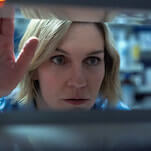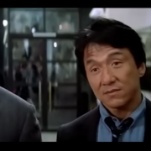Fringe: "The Cure"

There's nothing like cancer–or any disease, really–to remind us that no matter how much we romanticize our consciousness and our emotions, we're still just sacks of meat, stuffed with bones and tubes and a complicated system of microscopic organisms doing their own thing, often wholly independent of our elevated desires. Falling in love? Contemplating the divine? Craving a cheeseburger? That carcinoma spreading through your kidney doesn't care. It'll do what it'll do.
This of course has been a theme running through Fringe since Episode One, the idea that human beings are just devices. And that these devices can be transformed from something biological to something mechanical… like a communication device… or a bomb.
Tonight we saw one of the bombs. The episode opens with a woman stumbling into a Massachusetts diner–we know it's in Mass. because the counterman offers her some "wicked good vegetable soup"… also because it says so in big floating letters outside–and in typical Fringe pre-credits gross-out fashion, within minutes of the woman's arrival, everyone in the place is bleeding from the eyes until they fall over dead. (All except the woman. Her head explodes first.)
When the Fringe team arrives, they discover that the internal body temperature of the victims is so high that their brains must've boiled "like a Maine lobster." (Walter determines this by jamming a meat thermometer into one of the corpse's ears. That's right: a meat thermometer.) They also learn that the woman who inadvertently killed the diner patrons–one Emily Kramer–has a disease that I didn't quite catch the name of. It was referred to at one point as Bellini's, and of the two medical conditions by that name that I found on the internet, I'm pretty sure it was the one also known as "Collecting Duct Carcinoma" (and not the one that manifests as mental retardation). I apologize for not having these facts cold, but as far as the plot is concerned, this is a fairly unimportant detail. She had Rare Disease; that's what matters.
The team also locates another woman with Rare Disease: a Claire Williams, who's been recently abducted and is apparently being experimented on by the same medical research company that turned Emily into a walking microwave. The search for Claire leads the Fringies to a classic bad guy: an oily corporate visionary who talks about the great things we could accomplish if only we had the "resolve" to bypass our moral hang-ups. Here's all you need to kow about the bad guy: He's played by Chris Eigeman, one of my favorite actors, who excels at playing callous snobs. Naturally he nailed this part.
It's perhaps because of Eigeman's presence–and scenes like the one where a naked mole rat is set loose in a room with Claire until it inevitably bursts like a Karo-syrup-and-red-food-coloring-filled ballon–that I was predisposed to like "The Cure," despite some of Fringe's usual failings… and some failings I just noticed, too. I hadn't given much thought to the reasonability of the events that fit into The Pattern before now, because I'm not the kind of guy who looks for hard science in my science fiction. If a show tells me that a guy turning a big wooden wheel can make an entire island disappear, I just nod and wait to see what will become of it. And for now, I'm still willing to believe that these weekly experiments on human beings are for some higher purpose beyond "Wouldn't it be cool if…." That said, it does seem that these experiments are awfully messy and public and not very well covered-up. (Though maybe the sloppy execution is part of The Pattern too.)








































